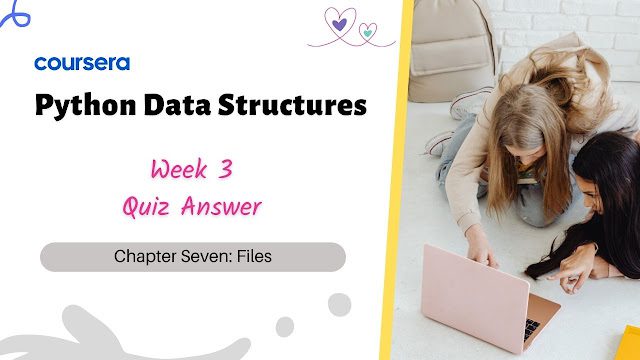Python Data Structures Week 3 Quiz Answers
Hello Friends in this article i am gone to share Coursera Course: Python Data Structures Week 3 Quiz Answers with you..
Python Data Structures
Go to this Course: Python Data Structures
Also visit this link: Python Data Structures Week 1 Quiz Answers
Python Data Structures Week 3 Quiz Answers
Chapter Seven: Files
Question 1) Given the architecture and terminology we introduced in Chapter 1, where are files stored?
- Main Memory
- Motherboard
- Secondary memory
- Central Processor
Question 2) What is stored in a “file handle” that is returned from a successful open() call?
- The handle contains the first 10 lines of a file
- The handle is a connection to the file’s data
- All the data from the file is read into memory and stored in the handle
- The handle has a list of all of the files in a particular folder on the hard drive
Question 3) What do we use the second parameter of the open() call to indicate?
- What disk drive the file is stored on
- The list of folders to be searched to find the file we want to open
- Whether we want to read data from the file or write data to the file
- How large we expect the file to be
Question 4) What Python function would you use if you wanted to prompt the user for a file name to open?
- cin
- read()
- file_input()
- input()
Question 5) What is the purpose of the newline character in text files?
- It enables random movement throughout the file
- It adds a new network connection to retrieve files from the network
- It indicates the end of one line of text and the beginning of another line of text
- It allows us to open more than one files and read them in a synchronized manner
Question 6) If we open a file as follows:
xfile = open('mbox.txt')
What statement would we use to read the file one line at a time?
- while ((line = xfile.readLine()) != null) {
- while (<xfile>) {
- READ xfile INTO LINE1
- for line in xfile:
Question 7) What is the purpose of the following Python code?
fhand = open(‘mbox.txt’)
x = 0
for line in fhand:
x = x + 1
print(x)
- Convert the lines in mbox.txt to lower case
- Count the lines in the file ‘mbox.txt’
- Reverse the order of the lines in mbox.txt
- Remove the leading and trailing spaces from each line in mbox.txt
Question 8) If you write a Python program to read a text file and you see extra blank lines in the output that are not present in the file input as shown below, what Python string function will likely solve the problem?
From: [email protected]
From: [email protected]
From: [email protected]
From: [email protected] …
- ljust()
- trim()
- split()
- rstrip()
Question 9) The following code sequence fails with a traceback when the user enters a file that does not exist. How would you avoid the traceback and make it so you could print out your own error message when a bad file name was entered?
fname = input(‘Enter the file name: ‘)
fhand = open(fname)
- signal handlers
- setjmp / longjmp
- try / catch / finally
- try / except
Question 10) What does the following Python code do?
fhand = open(‘mbox-short.txt’)
inp = fhand.read()
- Prompts the user for a file name
- Checks to see if the file exists and can be written
- Reads the entire file into the variable inp as a string
- Turns the text in the file into a graphic image like a PNG or JPG


These questions and answers are very good, I wanted to learn too.